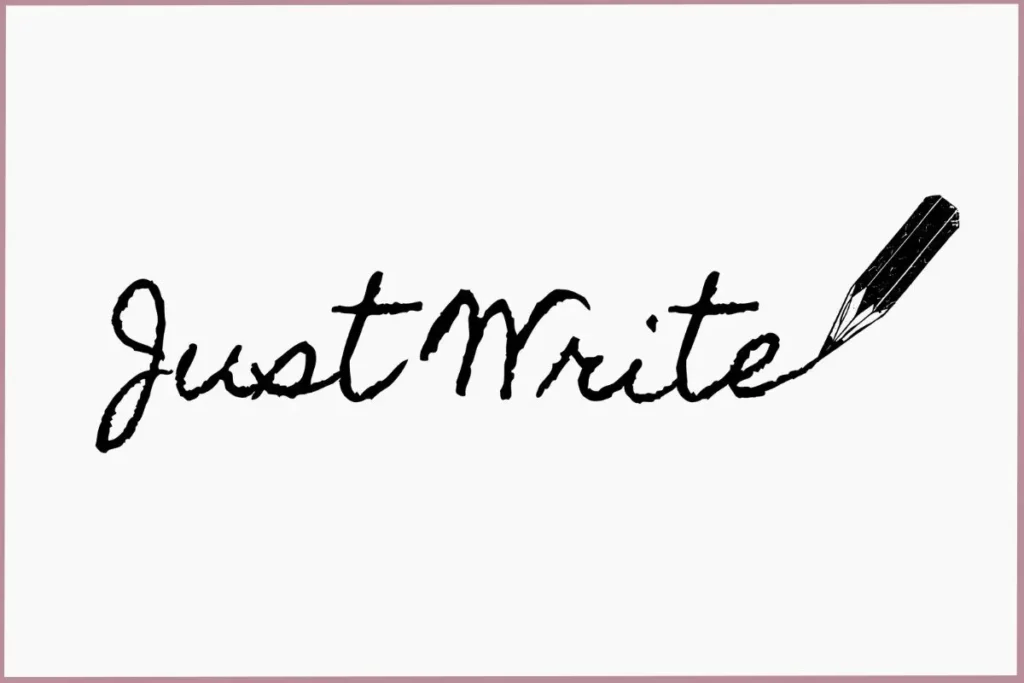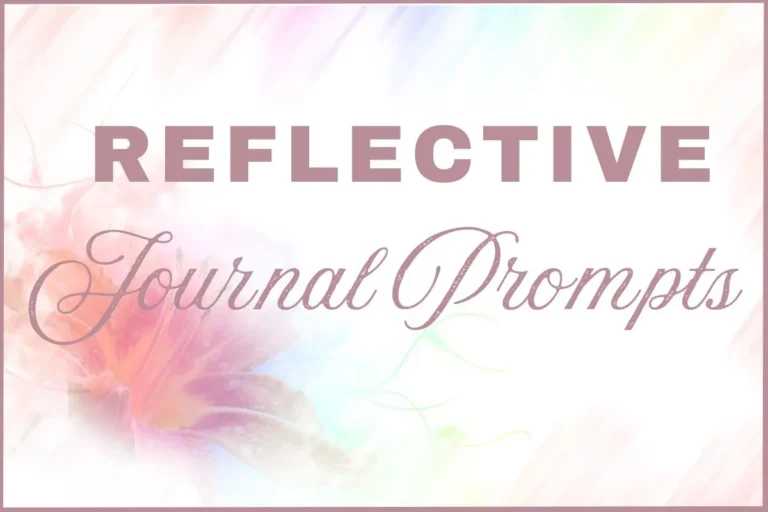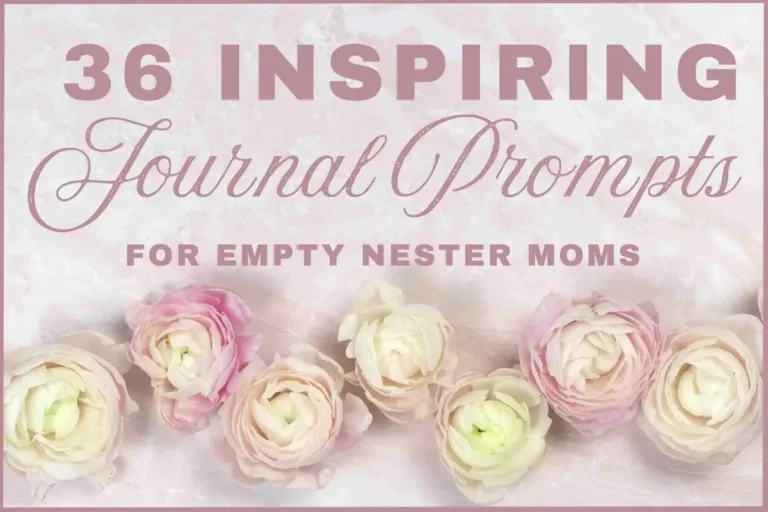Guide To Stream Of Consciousness Writing For Empty Nesters: Finding Your Voice
Ever feel like your mind is overflowing with thoughts that need a place to land?
Stream of consciousness writing offers a simple way to release those swirling ideas and find your voice.

For empty nester moms, it can be an incredibly freeing and creative outlet. This writing style allows you to put pen to paper – no rules, no judgment, just thoughts as they come.
It’s not only therapeutic but can also spark new perspectives and nurture creativity in ways you may not expect.
What is Stream of Consciousness Writing?

Stream of consciousness writing is a writing technique that captures real-time thoughts as they naturally occur. It’s a raw, unfiltered way of putting your mind on the page.
This free writing style can feel like opening a window into your own thoughts. It’s perfect for empty nester moms who want to reconnect with their inner selves.
If you’ve ever felt like your thoughts are a tangled ball of yarn, stream of consciousness writing lets you unravel it, one thread at a time.
This writing style is all about capturing your thoughts as they flow, without censorship or structure. Think of it as freewriting but a few steps looser.
It’s less about structure and more about authenticity, mimicking how the mind jumps between ideas and emotions. You needn’t worry about spelling, grammar, or making sense to anyone else. It’s private, spontaneous, and entirely yours.
Key features of this writing style include:
Unfiltered thoughts: Write whatever crosses your mind, no matter how random or disjointed.
Lack of structure: Sentences might start and stop abruptly or wander off-track, and that’s completely okay.
Personal tone: It’s intimate, often reflecting inner emotions, memories, or musings in real time.
There’s no wrong way nor is there any order to stream of consciousness writing. Just write as your thoughts flow.
If your mind jumps from remembering your morning coffee to wondering about next week’s weather, write it in this random order.
How Stream of Consciousness Writing Is Different From Traditional Journaling

At first glance, stream of consciousness writing may seem similar to journaling – they both involve putting thoughts onto paper.
However, there are key differences between the two practices, and understanding them can help you decide how to use each effectively.
Structure vs. Flow:
Journaling often follows a structure. You might reflect on specific events, keep a gratitude list, or record your goals. While journaling can be flexible, it usually has a sense of intention or direction.
Stream of consciousness writing, on the other hand, has no structure. It’s entirely free-flowing and unfiltered, allowing random, unrelated, or fragmented thoughts to spill onto the page.
Example of Stream of Consciousness Writing vs. Traditional Journaling:
Journaling might look like: “Today, I went for a walk and felt grateful for the beautiful weather.”
Stream of consciousness writing might look like: “The trees, green, too much green? Or maybe not enough, I need to buy milk, forgot it again. Why does that bird sound like laughter?”
Difference in Purpose:
Journaling is often used as a way to document and reflect on life events, set personal goals, or track progress. It’s highly intentional and focused on specific topics.
Stream of consciousness writing, by contrast, serves as a mental and emotional purge—helping you uncover hidden thoughts, release pent-up feelings, or just clear your mind. It’s more like releasing a dam and seeing what flows out.
Writing Tip: Use journaling when you want to organize or reflect on something specific. Use stream of consciousness writing when you want to unleash your raw, inner thoughts.
Difference in Terms of Self-Expression:
With journaling, you might feel more inclined to use complete sentences or coherent phrasing because you’re intentionally recording something meaningful for later reflection.
Stream of consciousness writing allows for chaotic, fragmented, or even nonsensical expression. It doesn’t have to make sense—it exists purely for the act of writing itself.
Writing Tip: Let go of any expectations with stream of consciousness writing. It’s not about capturing polished thoughts; it’s about embracing and exploring your unfiltered self.
End Goal or Outcome:
Journaling often encourages revisiting your entries to reflect on past experiences or lessons learned. In particular, journaling for self-discovery is a tool for self-awareness over time.
However, stream of consciousness writing doesn’t have an “end goal” in mind. The outcome isn’t meant to be revisited or analyzed unless you want to. It’s a present-moment exercise—a way to express, explore, and release without strings attached.
Writing Tip: Approach stream of consciousness writing as an in-the-moment activity. There’s no need to look for patterns or deeper meaning unless you naturally feel drawn to do so.
In short, journaling is a reflective practice that organizes and documents your life, while stream of consciousness writing is a liberating, raw, and spontaneous way of connecting with your innermost self.
Both serve different purposes, and you can use them together for a well-rounded writing habit.
12 Powerful Benefits of Stream of Consciousness Writing for Empty Nester Moms

You’ve spent years tending to your family, and now the house feels quieter. That transition can stir up a mix of emotions – loneliness, joy, confusion, or even relief.
Stream of consciousness writing offers a safe outlet to process those feelings without fear of judgment.
These are some of the top benefits of stream of consciousness writing:
1. Emotional release: This practice invites complete honesty, allowing you to pour out emotions you may struggle to express otherwise. By letting feelings flow freely onto the page, you create an outlet to process and understand them.
2. Stress relief: Putting thoughts onto paper can feel like unloading a heavy backpack. By jotting everything down, you free up mental space and reduce overwhelm.
3. Self-reflection: Writing in this way helps you better understand what’s bubbling under the surface. Sometimes, thoughts you weren’t aware of emerge, providing clarity.
4. Rediscovering identity: Now that your role as a full-time caregiver is shifting, this practice can help you explore who you are outside of parenthood. It’s a chance to reconnect with your own dreams and desires.
5. Exploring inner thoughts: Stream of consciousness writing dives deep into the layers of the mind. It can uncover hidden feelings, patterns, and insights, offering a glimpse into your truest self.
6. Freedom to break the rules: There’s no right or wrong way to approach this kind of writing. It removes expectations, lets you ignore structure, and encourages you to embrace imperfection. For moms adjusting to a new phase of life, this creative freedom can feel deeply liberating.
7. Improved mental clarity: Writing unfiltered thoughts helps untangle mental knots. It’s like clearing the clutter from a messy room, leaving you with a sense of focus and calm.
8. Creativity boost: By allowing thoughts to flow freely, you might discover creative ideas, solutions, or forgotten interests. It sparks imagination without the pressure of producing “perfect” work.
9. Emotional regulation: Regularly expressing emotions on paper can reduce anxiety, ease the empty-nester loneliness, and even boost mood. It provides a safe space to process complex feelings during this transition.
10. Healing & acceptance: Writing openly can be a form of self-healing. It helps you embrace this life stage and make peace with any lingering regrets or fears about your new role.
11. Strengthened intuition: As you reflect and write, you connect more deeply with your instincts and inner voice. This strengthens decision-making and builds confidence in your choices moving forward.
12. Unfiltered connection to self: Without external expectations, stream of consciousness writing lets you rebuild a connection with your authentic self that goes beyond your role as a parent.
Think of it as having a chat with yourself, but on paper. No interruptions, no filters, just your voice. Over time, it can feel like a reliable companion – a way to check in with your heart and mind.
Prefer traditional journaling over stream of consciousness journaling? Read about the benefits of journaling for self-discovery and maybe compare the two to make an informed decision.
How to Get Started with Stream of Consciousness Writing

If you’re new to stream of consciousness writing, starting can feel a bit intimidating. But it doesn’t have to be.
The beauty of this writing style is that there’s no right or wrong way to do it. It’s more about creating the right environment, finding inspiration, and silencing that inner critic. Let’s break it down step by step to make it easy and approachable.
Choose the Right Environment
The first step to get into the flow is setting yourself up in a space that fosters creativity and calm. You don’t need a fancy setup, just a spot that feels good to you.
Here’s what to consider:
- Find a quiet space: Whether it’s a cozy corner of your living room, your backyard, or even the kitchen table when the house is empty, choose somewhere free from distractions.
- Make it comfortable: Grab a notebook or a laptop—whichever feels more organic—and settle in with your favorite chair, blanket, or even a cup of tea.
- Limit interruptions: Turn off your phone notifications or let your family know you need some uninterrupted time. This is your moment to focus on yourself.
- Set the ambiance: Consider playing soft music or lighting a candle if that helps you feel more at ease. Small touches can make the space feel special and inviting.
This guide on how to start journaling for self-discovery offers useful tips that you can use for stream of consciousness writing too.
Remember, this is a time just for you. The goal is to create a space that feels safe and encourages your thoughts to flow freely.
Use Prompt Ideas to Inspire Writing
Generally, stream of consciousness writing does not involve or encourage the use of prompts. However, sometimes, staring at a blank page can feel overwhelming.
Using these types of inspiring journaling prompts can nudge your thoughts in a direction without forcing them.
Think of prompts as gentle starting points- they’re not meant to limit you, just to get your pen moving.
Here are a few ideas tailored to moms grappling with an empty nest:
- Write about a quiet morning. What do you hear, smell, or feel when the house is still?
- Remember a laughter-filled memory with your children and recount it in detail.
- Use these reflective journal prompts to ponder over how life has changed since your kids grew up. What feels different?
- Describe something small that brought you joy today, like a bird outside the window or a favorite cup of coffee.
- Write about your hopes for the future. What dreams or goals would you like to pursue?
- Imagine if you could talk to yourself as a younger mom. What advice would you give her?
If none of these resonate, simply jot down the first thing that comes to mind, even if it’s “I don’t know what to write.”
Often, starting with honesty can open the gates to deeper thoughts.
Tips for Overcoming Initial Hesitations
It’s common to feel unsure when you begin. Thoughts like, “What if I have nothing interesting to say?” or “What if my writing makes no sense?” might creep in.
Use these tips to push past those blank-page barriers:
Start with “I am here” or “Right now…”: These simple phrases ground you in the present moment and overcome the intimidation of a blank page.
Write without judgment: Remind yourself, no one will read this unless you want them to. You don’t need perfect words or polished ideas.
Set a timer: Sometimes, giving yourself a limit helps. Try writing nonstop for 10 minutes, even if it’s just scribbles. Think of it like warming up your brain.
Start small: You don’t have to fill pages. Even a few sentences can be a win. Over time, it gets easier.
Embrace imperfections: If your sentences trail off or your ideas jump around wildly, congrats—you’re doing it right! That’s the point of stream of consciousness.
Quiet the critic: Imagine your inner critic as a grumpy roommate. Acknowledge them, but don’t let them overpower your voice. You’re in charge.
Don’t lift your pen from the paper for at least 10 minutes: Continuous writing bypasses your internal editor and helps access deeper thoughts that might otherwise remain hidden.
Let your thoughts wander wherever they need to go: Natural thought patterns often reveal unexpected connections and insights that deliberate thinking might miss.
The key is to let go of any expectations. The moment you stop trying to control the process, writing becomes much more enjoyable.
Practical Applications of Stream of Consciousness Writing
Stream of consciousness writing isn’t just a creative outlet—it can be a practical tool for navigating life’s transitions, especially for empty nester moms.
From processing emotional shifts to creating a consistent self-care routine, this free-flowing writing style can support personal growth in meaningful ways. Let’s explore how it can fit into your life.
Using Writing to Process Life Transitions
As children grow up and leave home, it’s normal to feel a complex mix of emotions.
Excitement for their journey, sadness from the quiet house, and questions about “what’s next” for yourself can swirl together.
Writing through this transition can help you untangle those feelings.
Stream of consciousness writing allows you to release thoughts you may not even realize you’re carrying.
Think of it like having a honest conversation with yourself – no interruptions, no judgments. You can write down fears, hopes, or even things that frustrate you about this new chapter.
y putting emotions on paper, you might uncover patterns or perspectives that were hidden in the noise of your mind.
For example, you could start with something as simple as: “I miss the chaos of a full house, but I’m also excited about what’s possible now.”
From there, let your pen move freely.
- Do you feel a sense of freedom?
- Are there hobbies or goals you put on hold for years that you’re ready to revisit?
- The act of writing freely can help you process, accept, and even find joy in this new phase of life.
- Some questions to guide you might include:
- What does this stage of life mean to me?
- How do I feel about my identity now versus when I had young kids at home?
- What am I looking forward to doing for myself?
When you make time for this practice, you’re giving your emotions room to breathe and settle, which can feel therapeutic and empowering.
Incorporating Writing into a Routine
Life doesn’t always slow down when your kids leave. You might still have work obligations, volunteer commitments, or even grandchildren to care for.
So how do you make stream of consciousness writing a regular part of your day without it feeling like a chore?
- Start by keeping it simple: You don’t need hours to benefit from this practice—just five to ten minutes can make a difference. Here are some tips to integrate it into your routine:
- Pair it with an existing habit: Write while sipping your morning coffee or winding down before bed. Connecting it to a habit you already have will make it easier to stick with.
- Keep your tools accessible: Leave a notebook by your bedside table or create a shortcut on your phone for journaling apps, so it’s easy to start when inspiration strikes.
- Set a timer: Writing for just 7 minutes can help you stay focused and fit the habit into your schedule without feeling overwhelmed.
- Let go of pressure: It’s okay if some days you write a lot and other days only a sentence or two. Consistency matters more than perfection.
If your schedule feels unpredictable, treat writing like a flexible friend instead of a strict appointment. When you have a quiet moment, take advantage of it. And on busier days?
Remind yourself that even a few scribbled lines can be valuable. The goal isn’t to create a masterpiece; it’s to carve out small pockets of time to check in with yourself.
6 Common Mistakes to Avoid with Stream of Consciousness Writing

Even though stream of consciousness writing is a forgiving and flexible practice, there are a few common pitfalls that could diminish its effectiveness. By being aware of these mistakes, you can make the most of this technique and experience all its benefits.
1. Judging or Editing While Writing
A major mistake is overthinking or stopping mid-flow to correct grammar, sentence structure, or the way a thought is phrased.
This urge to perfect what you’re writing can interrupt your momentum and make the process feel constrained. Remember, the beauty of this practice lies in its looseness and imperfection.
Writing Tip: Let the words flow without correcting or restructuring anything. Think of it as talking freely to a close friend—no need for filters or fixing mistakes.
2. Thinking You Need to Be Perfect
Perfectionism is another common roadblock.
You might feel like your writing needs to sound profound, meaningful, or “just right,” but this pressure can rob the session of its cathartic quality. It’s not about creating a flawless piece of work—this is your space to be unapologetically you.
Writing Tip: Focus on capturing your thoughts as they come, however messy or random they might feel. The value lies in expressing, not impressing.
3. Censoring Your Thoughts
It’s easy to hold back on certain thoughts, especially if they feel silly, negative, or even a little alarming.
The fact is censoring yourself blocks the emotional release and insight this practice offers. Your writing doesn’t need to make sense or be “nice.” Every thought and feeling is valid in this space.
Writing Tip: Make a promise to yourself that no one else will read your writing unless you choose to share it. This is your private playground—grant yourself the freedom to explore it fully.
4. Focusing Too Much on Length
Another mistake is feeling pressured to write for a specific amount of time or reach a certain word count every session.
This can easily turn a relaxing practice into an overwhelming chore. Instead, embrace the idea that some days you’ll write a lot and other days just a little—and both are perfectly fine.
Writing Tip: Write until you feel done. That could mean two minutes some days and twenty minutes others. Follow your intuition, not a timer.
5. Only Using It When Stressed
You might view stream of consciousness writing as something to turn to only in tough times.
While it’s certainly helpful during moments of stress or sadness, limiting it to those times means you might miss out on its long-term benefits. Building a steady habit provides ongoing clarity and growth, even during calmer, happier phases of life.
Writing Tip: Make this a regular practice. Write a little every day or schedule time a few times a week to check in with your thoughts and emotions, regardless of how you’re feeling.
6. Thinking You Need to Stick to One Method
Being too rigid about how or when you write is another trap to avoid.
You might think you need to write by hand in a notebook, at a specific time of day, or following a certain routine. While rituals can be helpful, they shouldn’t turn into rigid rules that discourage you from writing when conditions aren’t perfect.
Writing Tip: Allow yourself flexibility. Whether you jot down thoughts on your phone during a quiet moment or use a laptop late at night, what matters is the act of writing, not how or when it happens.
By keeping these mistakes in mind and approaching stream of consciousness writing with openness and flexibility, you’ll create space for a practice that feels rewarding, freeing, and deeply personal.
Sharing vs. Keeping It Private
Once you’ve started filling pages with your thoughts, you might wonder: should you share this writing with others or keep it to yourself? The answer is entirely up to you and what feels right for your process.
For some, sharing pieces of their writing – whether with a close friend, partner, or even an online community – can provide a sense of connection. It allows others to understand what you’re experiencing and can spark meaningful conversations. Sharing may also remove the fear of judgment, as you begin to see the value and beauty in your unpolished, raw thoughts.
However, there’s absolutely no pressure to share if it doesn’t feel comfortable. Many moms find peace in keeping these writings private, like a personal diary. It becomes a safe space where they can express anything without worrying about others’ opinions. If you choose to keep it private, you might consider creating a ritual around it—writing in a beautiful notebook, for example, or tucking your pages away in a special drawer.
Feeling unsure? Here are a few questions to ask yourself:
Would sharing this help me feel more connected and understood?
Am I sharing because I want to, or because I think I should?
Does keeping it private allow me to be more honest in my writing?
There’s no right or wrong way to approach this. What matters most is what feels authentic and beneficial to you. Whether your writing remains tucked away in a journal or turns into heartfelt conversations, it’s still serving its purpose: helping you process, reflect, and grow.
Stream of consciousness writing is more than just a creative outlet—it’s a way to reconnect with yourself. For empty nester moms, it offers a chance to process emotions, explore new ideas, and rediscover pieces of your identity that may have been set aside. It’s simple, deeply personal, and endlessly rewarding.
There’s no need for perfection or rules, just a willingness to start. By giving yourself the freedom to write without filters, you might uncover new perspectives and possibilities you hadn’t imagined.
Why not take five minutes today to see where your thoughts lead? You might be surprised at the clarity and peace it brings.







